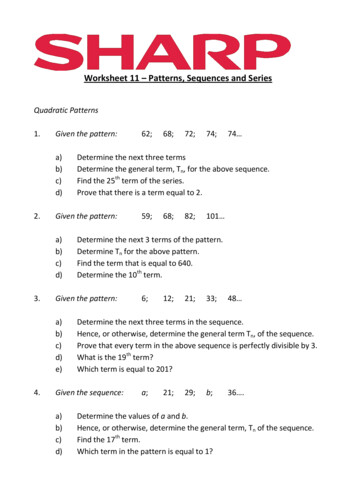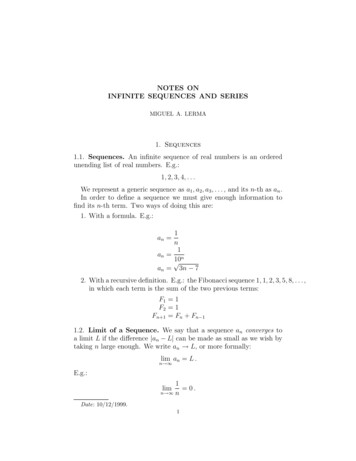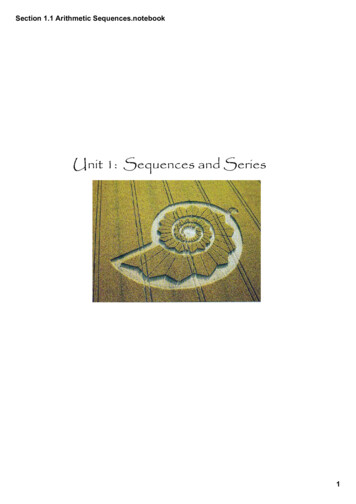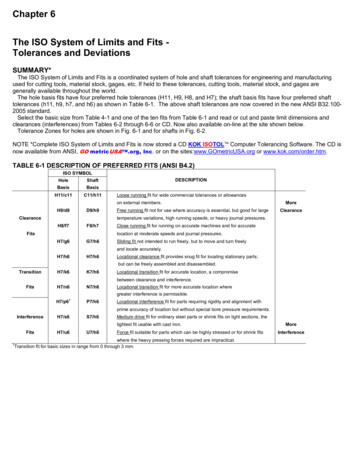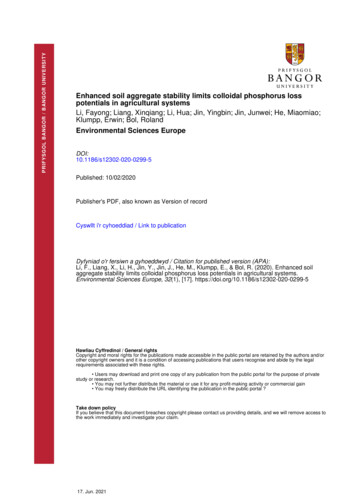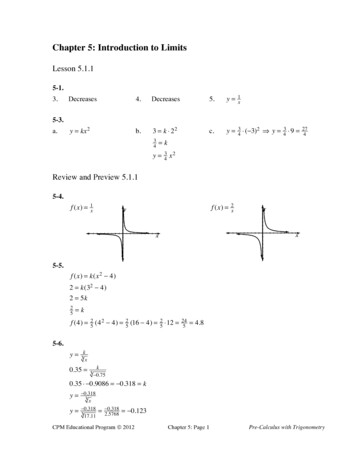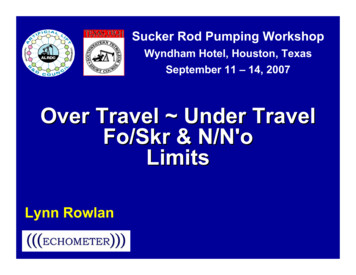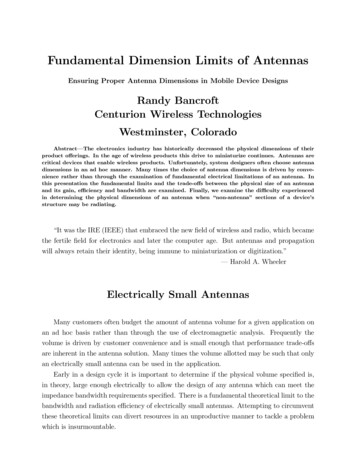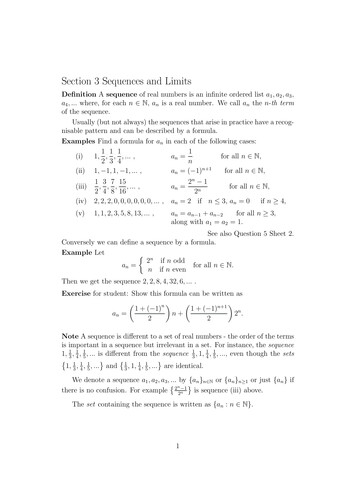
Transcription
Section 3 Sequences and LimitsDefinition A sequence of real numbers is an infinite ordered list a1 , a2 , a3 ,a4 , . where, for each n N, an is a real number. We call an the n-th termof the sequence.Usually (but not always) the sequences that arise in practice have a recognisable pattern and can be described by a formula.Examples Find a formula for an in each of the following cases:11 1 1(i)1, , , , . ,an for all n N,2 3 4n(ii) 1, 1, 1, 1, . ,an ( 1)n 1for all n N,(iv)1 3 7 15, , , , . ,2 4 8 162, 2, 2, 0, 0, 0, 0, 0, 0, . ,(v)1, 1, 2, 3, 5, 8, 13, . ,(iii)2n 1for all n N,2nan 2 if n 3, an 0if n 4,an an an 1 an 2for all n 3,along with a1 a2 1.See also Question 5 Sheet 2.Conversely we can define a sequence by a formula.Example Let n2 if n oddan for all n N.n if n evenThen we get the sequence 2, 2, 8, 4, 32, 6, . .Exercise for student: Show this formula can be written as 1 ( 1)n 11 ( 1)nn 2n .an 22Note A sequence is different to a set of real numbers - the order of the termsis important in a sequence but irrelevant in a set. For instance, the sequence1, 31 , 14 , 15 , . is different from the sequence 13 , 1, 41 , 51 , ., even though the sets 1 1 1 1, 3 , 4 , 5 , . and 31 , 1, 14 , 15 , . are identical.We denote a sequence a1 , a2 , a3 , . by {an }n N or {an }n 1 or just {an } if nthere is no confusion. For example 2 2 1is sequence (iii) above.nThe set containing the sequence is written as {an : n N}.1
Definition A real number is said to be a limit of a sequence {an }n N if,and only if,for every ε 0, there exists N N such that an ε for all n Nor, in mathematical notation, ε 0, N N : n N, an ε.Note. To check, or verify that this definition holds we have to:(i) Guess the value of the limit ,(ii) Assume ε 0 has been given,(iii) Find N N such that an ε, i.e. ε an ε for alln N.We have to be able to find such an N for each and every ε 0 and, ingeneral, the N will depend on ε. So you will often see N written as a functionof ε, i.e. N (ε).See Questions 8 and 9 Sheet 2Definition A sequence which has a limit is said to be convergent. Asequence with no limit is called divergent. Example The sequence n1 n N is convergent with limit 0.Solution This is simply the Archimedean Principle. We have to verify thedefinition above with 0.Let ε 0 be given. (So we have no choice over ε, it can be any suchnumber.)The Archimedean Principle says that we can find N N such that N1 ε.But then, for all n N we have111 0 ε.nnNHence we have verified the definition with 0 which must, therefore,be a limit of the sequence n1 n N . The question remains whether the sequence n1 n N has other limits.Note how in the definition I talked about being a limit, not the limit. Thefollowing result answers this in the negative.2
Theorem 3.1 If a sequence of real numbers {an }n N has a limit, then thislimit is unique.Proof by contradiction.We hope to prove “For all convergent sequences the limit is unique”.The negation of this is “There exists at least one convergent sequencewhich does not have a unique limit”.This is what we assume.On the basis of this assumption let{an }n N denote a sequence with morethan one limit, two of which are labelled as 1 and 2 with 1 6 2 .Choose ε 31 1 2 which is greater than zero since 1 6 2 .Since 1 is a limit of {an }n N we can apply the definition of limit with ourchoice of ε to find N1 N such that an 1 ε for all n N1 .Similarly, as 2 is a limit of {an }n N we can apply the definition of limit withour choice of ε to find N2 N such that an 2 ε for all n N2 .(There is no reason to assume that in the two uses of the definition oflimit we should find the same N N for the different 1 and 2 . They maywell be different which is why I have labelled them differently as N1 and N2 .)Choose any m0 max(N1 , N2 ), then am0 1 ε and am0 2 ε.This shows that 1 is “close to” am0 and 2 is also “close to” am0 . Hence wemust have that 1 is “close to” 2 . Using the Triangle inequality, Theorem1.2, we can remove the am0 in the following way: (TRICK) 1 2 1 am0 am0 2 1 am0 am0 2 , ε ε, 2ε 32 1 2 ,“adding in zero”triangle inequality,by the choice of m0 ,by the definition of ε.So we find that 1 2 , which is not zero, satisfies 1 2 23 1 2 ,which is a contradiction.Hence our assumption must be false, that is, there does not exist a sequence with more than one limit. Hence for all convergent sequences thelimit is unique. 3
Notation Suppose {an }n N is convergent. Then by Theorem 3.1 the limitis unique and so we can write it as , say. Then we write limn an orLn an or an as n .In particular, the above example shows that1 0.n nlim nExample What is the limit of 1 12?n NSolution Rough work17 31The first few terms are: 12 , 45 , 78 , 16, 32 , . .It appears that the terms are getting closer to 1.To prove this we have to consider an 1 n1 an 1 121 21 n 1 2345678910141811613216411281256151211024 1 n2.Let ε 0 be given. We have to show that there exists N N such that an 1 ε for all n N.Consider some particular choices of ε.ε ε ε 1:101:1001:1000for all n 4 an 1 for all n 7 an 1 for all n 10 an 1 11 16 2n1 ε,1281 ε.1024ε,Note how these values of N , namely 4, 7, 10, etc., get larger as ε getssmaller.End of rough workCompletion of solution. By the Archimedean property we can find N Nsuch that N1 ε. For any n N we have 2n n and so, for all n N wehave an 1 111 εn2nNas required. 4
Examples Discuss the convergence or otherwise of the following sequences.(i)2, 2, 2, . ,convergent limit 2,(ii)convergent(iii)2 21 , 2 13 , 2 14 , . ,3 2, 3 22 , 3 23 , 3(iv)1, 2, 1, 2, . ,(v)1, 1 21 , 31 , 1 13 , 14 , 1 41 , .2(vi)2, 4, 6, 8, . , 24 , . ,limit 2,convergent limit 3,divergent,,divergent,divergent,(vii) 1, 4, 9, 25, . .divergent.Example Show, by using the Archimedean principle to verify the definition,that sequence (iii) has limit 3.SolutionRough workThe nth term can be written as( 1)n 1 2.nSo, an 3 n2 . We will want to find N N such that n2 ε for all n N ,i.e. n1 2ε for such n. Again we will do this by the Archimedean Principle.an 3 End of Rough workProofLet ε 0 be given. By the Archimedean property we can find N Nsuch that N1 2ε . Then for all n N we have an 3 22 εnNas required. Definition A sequence {an }n N is said to be bounded if the set {an : n N} {a1 , a2 , a3 , a4 , .} is bounded.Similarly a sequence is said to be bounded above or bounded below if theset is bounded above or bounded below respectively.Example 1, 2, 1, 2, 1, 2. is a bounded sequence.5
Theorem 3.2 If {an }n N is a convergent sequence, then {an }n N is a boundedsequence.ProofLet be the limit of {an }n N . In the definition of limit choose ε 1 tofind N N such that an 1 for all n N. Rewriting, this says that 1 an 1, for all n N,or that the set {aN , aN 1 , aN 2 , .} is bounded.Yet the set {a1 , a2 , a3 , .aN 1 } is bounded, above by max {ai : 1 1 N 1}and from below by min {ai : 1 1 N 1} . These maximum and minimums can be calculated simply because the set is finite.If A, B are bounded sets then A B is bounded.(Exercise, prove this, but see also Question 3, sheet 2)Hence {a1 , a2 , a3 , .aN 1 } {aN , aN 1 , aN 2 , .} {a1 , a2 , a3 , .} isbounded as is, therefore, the original sequence. Corollary 3.3 If {an }n N is an unbounded sequence, then {an }n N is divergent.Proof : This is just a restatement of Theorem 3.2.The statement of Theorem 3.2 is of the form “If p then q”, often writtenas “p q”. This has been discussed in the appendix to part 2. We alsosaw there that we represent the negation of a proposition p as p. In otherwords, p means that p does not hold.If we had both p q and q p we could combine to deduce q p q, i.e. q q. It would be a strange world if, assuming that q doesnot hold we could then deduce that q did hold. For this reason we say thatp q and q p are inconsistent.Without proof I state that p q and q p are consistent. In factthey are logically equivalent in that if one statement is false than so is theother and if one is true then so is the other. See the appendix to part 2for more details of equivalence. We say that q p is the contrapositiveof p q. The statement of Corollary 3.3 is simply the contrapositive ofTheorem 3.2. Example The sequence 1 21 , 2 13 , 3 14 , 4 51 , . is not bounded above and thus itis divergent.Proof by contradiction.Assume the sequence is bounded above by λ, say. By the alternativeArchimedean principle, Theorem 2.1 , we can find n N such that n λ.6
11But then n n 1is an element of the sequence satisfying n n 1 n λ,which is a contradiction.Hence our assumption is false, thus the sequence is not bounded above. Definition A sequence {bn }n N is called a subsequence of {an }n N if, andonly if, all of the terms of {bn }n N occur amongst the terms of {an }n N inthe same order.Examples(i) an n1 , bn 1,2nso {an }n N 1 1 1 1 11, , , , , , .2 3 4 5 6and {bn }n N 1 1 1 1 1, , , , , .2 4 6 8 10which is a subsequence of {an }n N .(ii)(iii)31 63 127, , , .32 64 128, is a subsequence of 12 , 43 , 78 , 15, 31 , 63 , 127 , . .16 32 64 1281 1 1 1 1, , , , , .4 2 6 8 10, is not a subsequence of 12 , 31 , 14 , 51 , 61 , . .Notes (a) We can look upon a subsequence {bn }n N as the original sequence,{am }m N , with terms deleted and the remaining ones relabelled. For example:a1a2a3b1b2a4a5.b3.am-1amam 1.bnbn 1.From this we can see that each bn comes from some am where n and msatisfym n (the number of ai , 1 i m 1, that have been deleted).In particular m n. Hence we have n 1, m n : bn am .7
The fact that the relabelling retains the ordering means that if bn amand bn0 am0 then n n0 if, and only if, m m0 .(b) Example (ii) illustrates the common method of forming a subsequenceby omitting a finite number of initial terms of a given sequence.Theorem 3.4 If a sequence converges then all subsequences converge andall convergent subsequences converge to the same limit.Proof Let {an }n N be any convergent sequence. Denote the limit by .Let {bn }n N be any subsequence.Let ε 0 be given. By the definition of convergence for {an }n N thereexists N N such that an ε for all n N . But this value N willalso work for {bn }n N . This is because if n N then bn am for somem n N and so bn am ε. Thus bn ε for all n Nas required. Question What is the contrapositive of Theorem 3.4?Question What is the negation of “all subsequences converge and all convergent subsequences converge to the same limit.”?In logic, if it is not the case that both p and q holds then either p doesnot hold or q does not hold. We could write this as saying “not (p and q)”is logically equivalent to “either (not p) or (not q)”. Thus, the negation of“all subsequences converge and all convergent subsequences converge to thesame limit” is “either (not all subsequences converge) or (not all convergentsubsequences have the same limit)” This is the same as “either (there existsa diverging subsequence) or (there are two converging subsequences withdifferent limits).”So the contrapositive of Theorem 3.4 is:Corollary 3.5 If {an }n N is a sequence that either has a subsequence thatdiverges or two convergent subsequences with different limits then {an }n Nis divergent.Example The sequence 1, 2, 1, 2, 1, 2, . is divergent.Solution Consider the two subsequences 1, 1, 1, . and 2, 2, 2, ., both convergent though with different limits, 1 and 2. Hence by the Corollary thesequence 1, 2, 1, 2, 1, 2, . diverges. Example The sequence 1, 2, 3, 1, 2, 3, 1, 2, 3, . is divergent.Solution Our sequence has a subsequence 1, 2, 1, 2, 1, 2, . which, by the previous example, is divergent. Hence by the Corollary the sequence 1, 2, 3, 1, 2, 3, 1, 2, 3, .diverges. 8
Note The sequence 1, 2, 3, 1, 2, 3, 1, 2, 3, . is bounded but divergent. Thus,{an }n N being bounded doesn’t necessarily mean it is convergent.Remember these results assequence convergent sequence bounded,butsequence bounded ; sequence convergent.Aside Something you might try to proveTheorem Every bounded sequence has a convergent subsequence.Proof Not givenEnd of aside.Definition A sequence {an }n N is said to be increasing (or non-decreasing)if an an 1 for all n N. (So a1 a2 a3 a4 . .)A sequence {an }n N is said to be decreasing (or non-increasing) ifan an 1 for all n N. (So a1 a2 a3 a4 . .)A monotone sequence is one that is either increasing or decreasing.A sequence is strictly increasing if an an 1 for all n N, is strictlydecreasing if an an 1 for all n N and is strictly monotone if it iseither strictly increasing or strictly decreasing.Theorem 3.6 Let {an }n N be a increasing sequence which is bounded above.Then the sequence converges with limit lub{an : n N}.ProofThe set {an : n N} is non-empty is bounded above by the assumptionof the theorem. So, by the Completeness of R, Property 10, the set has aleast upper bound. Denote lub{an : n N} by β.We have to verify the definition of convergence with limit β.Let ε 0 be given. By Theorem 2.2 there exists N N such thatβ ε aN .(In words: β is the least of all upper bounds, but β ε is less than β socannot be an upper bound and thus must be less than some element in theset.)Since the sequence is increasing we haveβ ε aN aN 1 aN 2 .,9
that is, β ε an for all n N .But β is an upper bound for the set soβ ε an β β ε or an β εfor all n N .Thus we have verified the definition of convergence with limit β lub{an
Let ε 0 be given. (So we have no choice over ε, it can be any such number.) . bounded as is, therefore, the original sequence. Corollary 3.3 If {a n} n N is an unbounded sequence, then {a n} n N is diver-gent. Proof: This is just a restatement of Theorem 3.2. The statement of Theorem 3.2 is of the form “If p then q”, often written as “p q”. This has been discussed in the .
